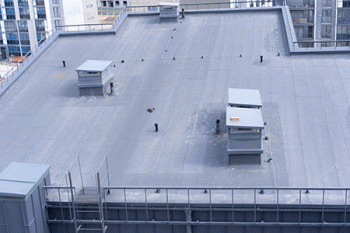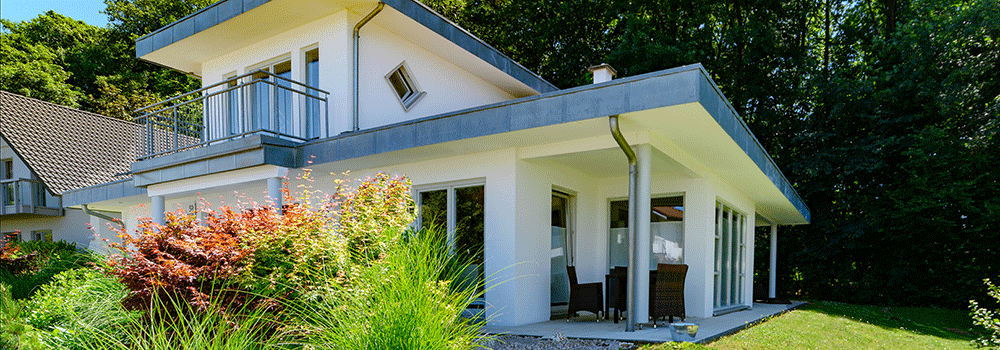The Difference Between Pitched Roofs and Flat Roofs
When people think of pitched roofs versus flat roofs, they often envision the classic teepee-style triangle roof versus a perfectly flat roof on top of a commercial building. However, no roof is actually completely flat. It’s more accurate to refer to pitched roofs as steep-slope roofs and flat roofs as low-slope roofs.
To measure a roof’s slope, clarify how many inches the roof falls over a twelve-inch distance. Most low-slope roofs have a slope of three and twelve or less, meaning that the roof’s slope decreases by three inches over a foot-long distance. Pitched roofs typically have slopes of four and twelve or more.
Most low-slope roofs are made of a single-ply membrane, a built-up membrane, or monolithic sprayed foam. Since the slope of a flat roof is so small, the roof is at risk of leaking after rainfall. A membrane system allows for standing water to drain to hopefully avoid those sorts of leaks. Meanwhile, pitched roofs can be covered with shingles, slate, clay, or metal.
Advantages of a Flat Roof
Low-slope roofs are not suitable for every type of structure. However, they certainly have advantages over pitched roofs in some situations.
Cost of Installation
Low-slope roofs cover less surface area than steep-slope roofs. As a result, the cost of materials and labor related to installation can often be much lower than that of pitched-roof installation. This is not always the case, so make sure to carefully review any quotes or bids provided by professional roofing companies.

Additional Space Inside the Building
A low-slope roof essentially creates another floor to the structure. Some commercial building owners may opt to use the flat roof as storage for things such as large machinery to create more space inside the building.
Easy Technology Implementation
Low-slope roofs make it easy to implement technology such as solar panels or other energy-efficient innovations. Additionally, low-slope roofs are ideal locations for rooftop gardens which can help the environment while also providing insulation to the building. Low-slope roofs can be good on the Earth and great on the wallet!
Energy Efficiency
Flat roofs are generally regarded as one of the most energy-efficient roofing options. Pitched roofs can lose a lot of heat during the winter (and cool air during the summer) if not properly insulated. Flat roofs are less likely to have those issues.
More Natural Light
Flat roofs don’t have the same sort of angled overhangs that pitched roofs have. Often, overhangs block the amount of light that can enter the building. Take away the overhang and let there be light! Natural light in both the workplace and the home has numerous physical and mental health benefits.
Disadvantages of a Flat Roof
Flat roofs are typically more appropriate for commercial buildings or in areas that do not receive much rainfall or other precipitation. Keep in mind these disadvantages of low-slope roofs before making any decisions about a new roof.
More Maintenance Than Pitched Roofs
Flat roofs may be cheaper to install upfront, but over time, they cost more in maintenance. Low-slope roofs have a harder time shedding rain and snow than pitched roofs. As a result, the roof may have puddles of standing water in certain areas. Standing water can cause issues with flat roofs, so it’s important to periodically check low-slope roofs for problem areas. Also, leaks are much harder to isolate on low-slope roofs.
Additionally, the angled overhangs of pitched roofs help clear water and snow from the top of the structure. The angle of the overhang on a pitched roof prevents debris from hitting the side of the house. A pitched roof may result in higher roof installation costs, but it will likely save building owners money in relation to siding, window, door, and deck maintenance. Flat roofs require much more maintenance than pitched roofs due to the membrane system needed to drain standing water.
Shingles Are Cheaper
Shingles are much cheaper than membrane systems. However, shingles cannot be installed on any roof with a pitch that’s three and twelve or lower. When flat roofs are more expensive to install, it’s likely because of the cost of materials.
Shorter Roof Lifespan
In general, flat roofs have a shorter usable lifespan than pitched roofs. Many new membrane systems come with a fifty-year warranty, but if the building is in an area that receives a lot of rainfall, the membrane system may not last that long. Make sure to consult with a roofing professional before deciding on a specific roof-type for any structure.
Flat Roof or Pitched Roof?
While every structure has its own unique features to consider, there are a few generalities that may be useful to consider when making the decision between a pitched roof and a flat roof. For instance, flat roofs are generally better-suited for areas that receive little to no rainfall each year. Flat roofs are also popular choices for commercial buildings or for buildings on which rooftop access is necessary (such as hospitals or apartment buildings with rooftop terraces). If aesthetics are a top concern, keep in mind that flat roofs are often associated with a more modern design than pitched roofs.
How Can We Help?
The roofing professionals at Precision Roofing & Gutters serve the entire Portland-metro area in the Pacific Northwest. From gutter cleaning to new roof installation, we can handle it all! We use environmentally friendly materials in our contracting projects, and we aim to provide the best customer service along with our high-quality craftsmanship. Our professional roofers can also help homeowners make the best decision for their home. We comply with all HOA and local regulations to ensure that every new project is completed satisfactorily. Call today for a free estimate for any roofing-related projects in the Portland area!

